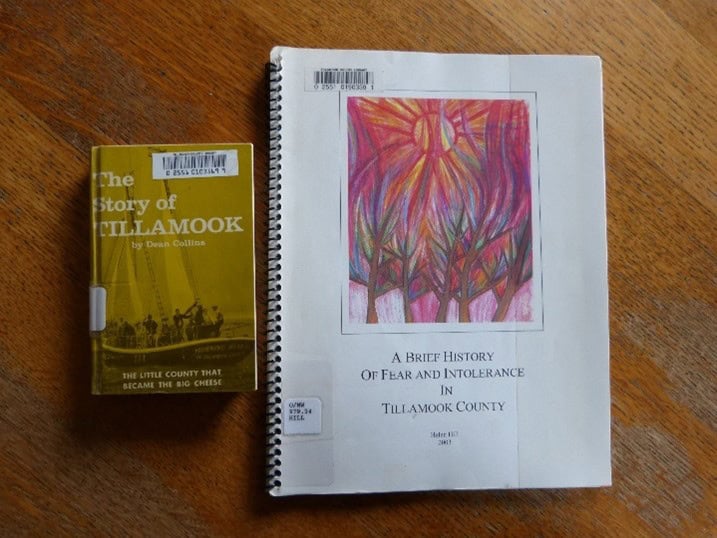EDITOR’S NOTE: Two books about the history of our county, written 70 years apart with different focuses and views …
By Jim Heffernan
A Brief History of Fear and Intolerance in Tillamook County by Helen Hill, 2003, 60 pages, Available at Tillamook County Library
The Story of Tillamook-The Little County That Became the Big Cheese by Dean Collins,1933, 275 (Little) Pages, Available at Tillamook Public Library, I’m guessing the 275 pages is roughly equivalent to to 65 typewritten pages.
I heard of the Helen Hill book and was just attracted to it. It is now “out of print”, but the library has maybe 6 copies of it in the alcove dedicated to Oregon and Northwest history. While I was there, the cute little book by Dean Collins jumped into my hands.
Helen Hill’s book begins with our shameful dealings with the indigenous people who had inhabited this area for thousands of years, goes on to tell of the 1920’s when the Ku Klux Klan (KKK) was very popular, and concludes in the 1990’s when the Oregon Citizens’s Aliance (OCA) wanted so much to keep us safe from deviants with different beliefs.
Basically, the original inhabitants were told that they were just visitors, the place belongs to us Europeans now. Diseases such as smallpox and measles seemingly cooperated with us, killing the majority of the people who were here first. By 1875, the few remaining indigenous inhabitants were removed to Grande Ronde. They exist here today only in place names, Tillamook, Kilchis, Nestucca, and Nehalem.
Just after World War I, the Ku Klux Klan became a prominent force in the county and throughout the state. I never would have guessed that Oregon would have ever had a “compulsory sterilization” and a “sundown law”.
The “compulsory sterilization” law was passed in 1917 and stated that the feeble, insane and those likely to be wards of the state should be forcefully sterilized to protect society’s gene pool. This barbarous practice was dignified by the term “Eugenics” and remained on the law books until 1983.
The ”sundown law” stated that no Negro, Chinese, or Japanese person was allowed within the City limits after sundown. It was instituted in 1919 and remained on the books until the 1960’s. In the 1930’s it was used to keep a black crew who had been brought in to fight the Tillamook Burn from staying in town.
For no good reason, Tillamook was fertile ground for the Klu Klux Klan (KKK). A lodge was established in 1922 and the mayor and police chief were proud members. The Klan was the driving force behind the Compulsory School Bill which forbid anything but public schools and demanded that all youths attend them. To the Klan, Catholic schools were a menace to “100% Americanism”. The KKK stood staunchly for “law and order” and had the nerve to say their ideal was the life of Christ. Somehow, remnants of their sentiments survive 100 years later.
The Compulsory School Bill was only in force for a year before it was declared unconstitutional by the U.S. Supreme Court.
Helen points out the similarities between the viewpoints of the Klan and the Oregon Citzen’s Alliance (OCA) that gained some political prominence in the 1990’s. They were worried about society being corrupted by homosexuals gaining “special status”. A couple of initiatives made it to the ballot and were barely defeated in Tillamook County.
Echoes of OCA view points persist today.
Despite the dark subject, I found Helen Hill’s book very entertaining and I think it’s a good thing to shine a light on how our history is not all sweetness and joy.
“The Story of Tillamook” is an entirely different sort of book. It was written in 1933 by Dean Collins, a man who calls himself, the “cheese investigator”. It’s divided into 22 chapters, spanning the time from August 18, 1933 to September 1, 1933. August 26 gets three chapters, one talking about the “pretty bad” fire we now call the Tillamook Burn.
He introduces us to people like Joe Champion, Henry Wilson, and Eldridge Trask who were the earliest Europeans to arrive. He also talks with Peter McIntosh, Fred Christianson, Carl Habelack, Jim Williams, Guy Ford, and others who perfected our particular style of cheese.
It’s fitting that a lot of the book is devoted to cheese making, after all he does call himself the “cheese investigator”. He does not approach the subject from the dry technical details of making cheese, but in short personal profiles of the people who worked so hard to standardize cheese production so that the final product was always the same and always good.
I recommend both books without reservation.


